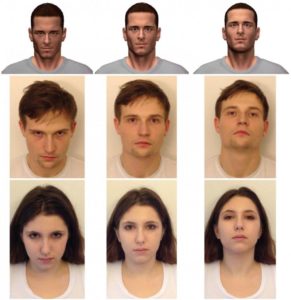When glancing at a stranger, we don’t have to stop and chat to get a sense of how they’re feeling. We instinctively know what narrowed eyes, a furrowed brow, or a twitch of a smile means. We’re facial expression experts. Or are we?
According to new research from the University of British Columbia we might be seeing facial expressions that don’t exist, all because of the tilt of the head.
Researchers Zachary Witkower and Jessica Tracy have been working on a series of studies that examine how different head positions impact perceptions of dominance.
In the first study, 101 participants were asked to rate facial avatars based on how strongly they agreed with statements of dominance. Examples of these statements include “This person would enjoy having control over others” and “This person would be willing to use aggressive tactics to get their way”.
All the avatars had neutral expressions, but each was pictured with three head positions – tilted up, down and level (neutral).

The results showed that avatars with downward head tilts were perceived as significantly more dominant than those with neutral or upward-tilted heads. The same pattern was confirmed in a second study using images of actual people.
“These findings suggest that ‘neutral’ faces can still be quite communicative,” explain Witkower and Tracy. “Subtle shifts of the head can have profound effects on social perception.”
But what exactly is it that implies dominance? According to a series of follow up studies, it’s all in the eyebrows.
The researchers explain that a forward tilt can have a big impact on facial features, and the angles between them. If you maintain eye contact, a downward tilt makes eyebrows appear lower and V-shaped, even though they haven’t moved. This creates the illusion of a frown which can be read as aggression, intimidation, and dominance.
Intrigued, the researchers are continuing to investigate the influence of head tilt on how we interpret facial expressions. But in the meantime, remember that your poker face might not be as neutral as you think.









































